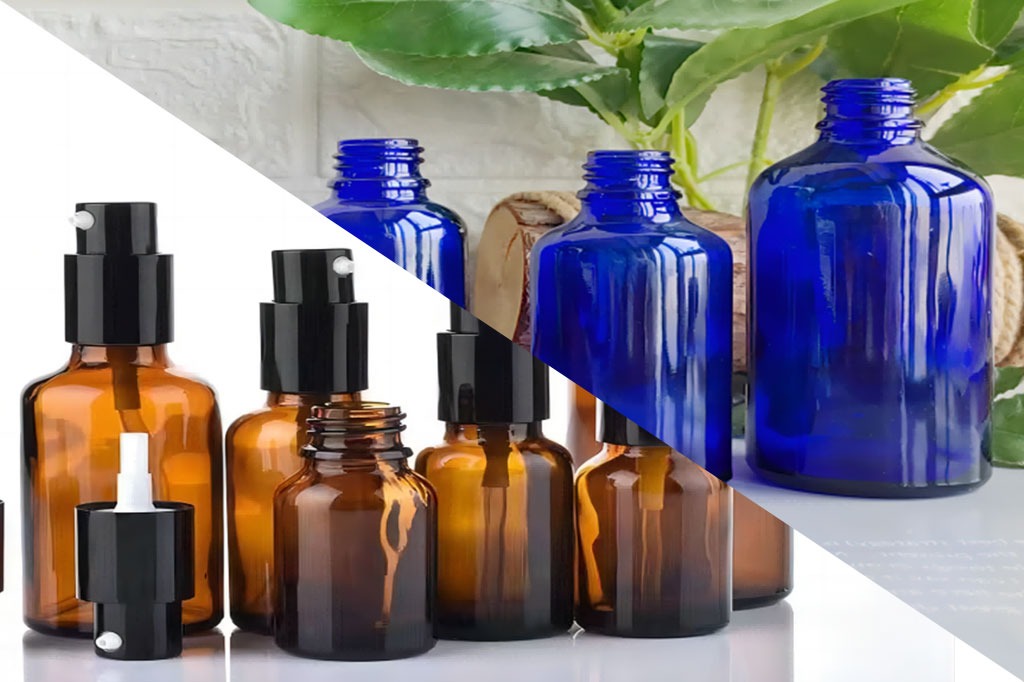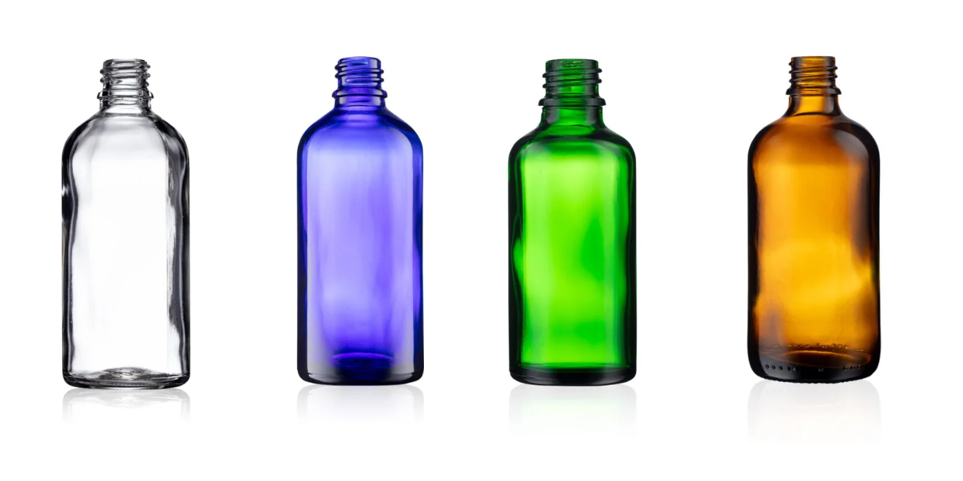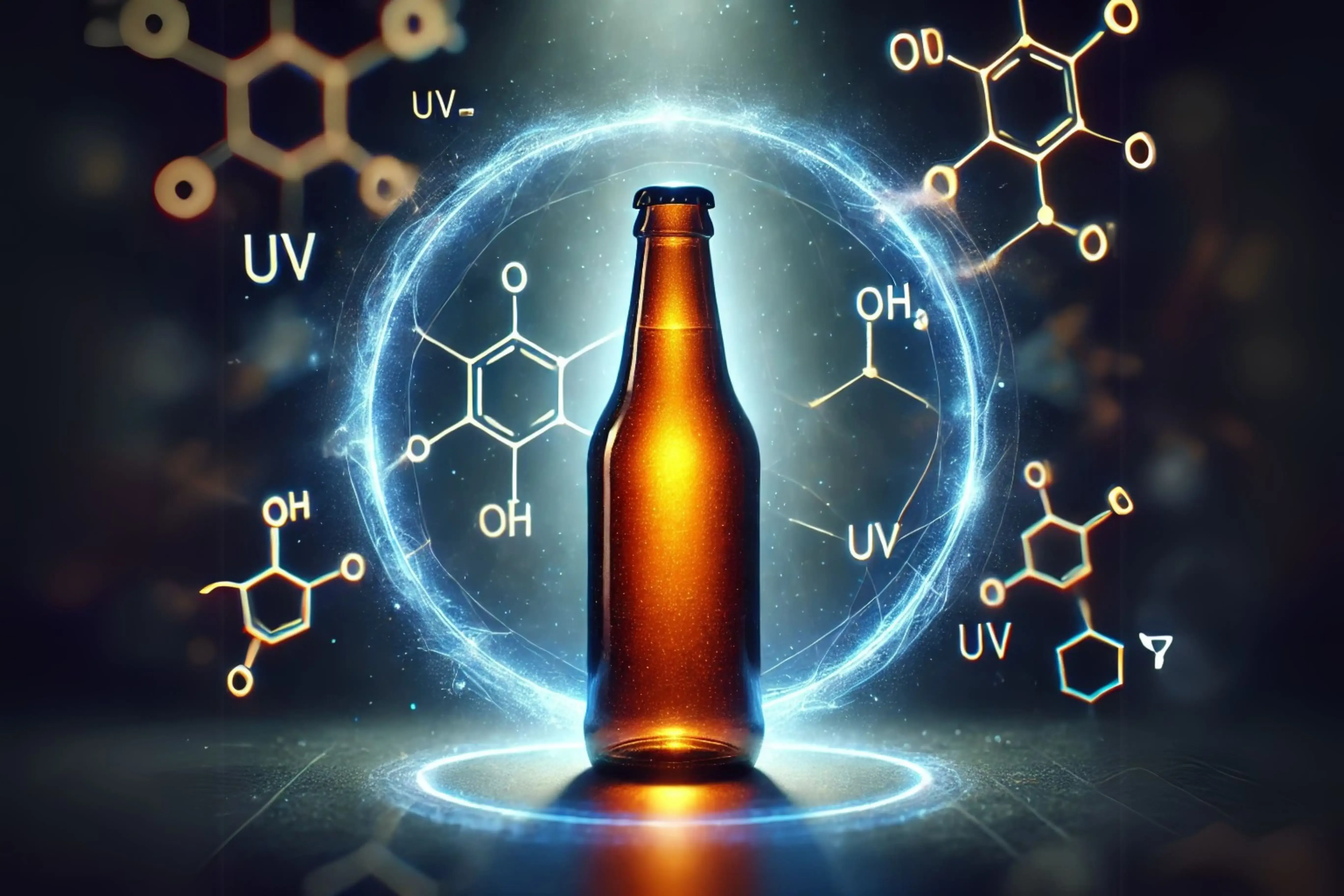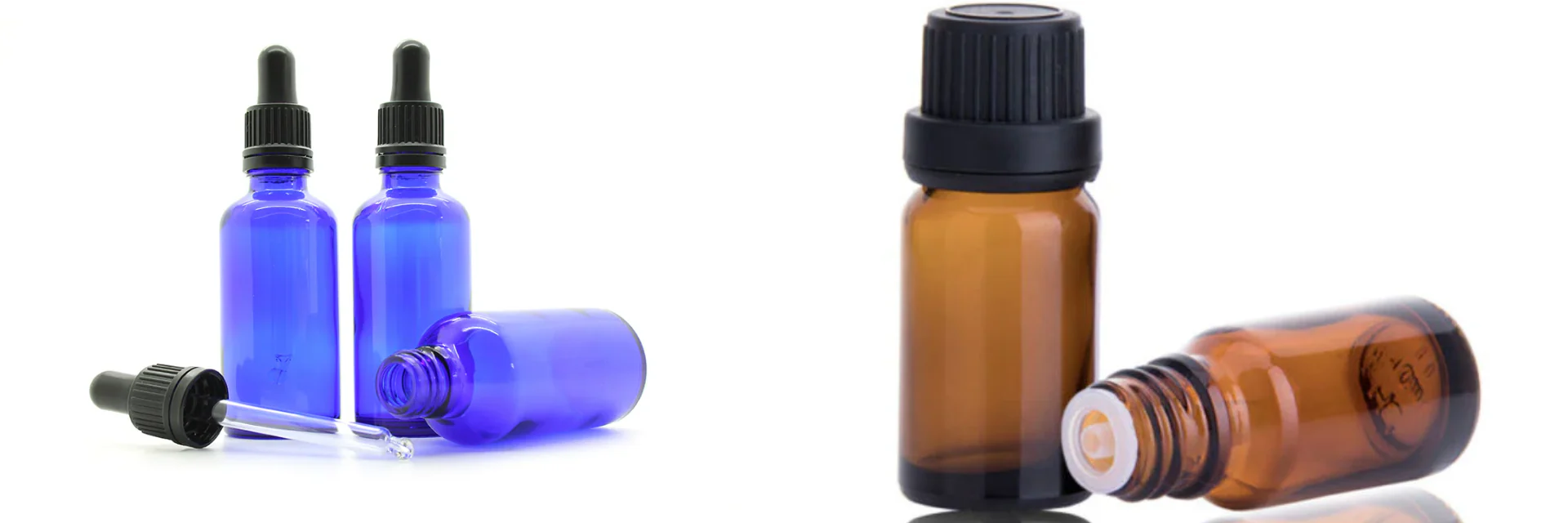When packaging photosensitive products like essential oils, vitamins, or certain skincare formulations, protecting them from ultraviolet (UV) light is a primary concern. UV radiation can degrade active ingredients, leading to reduced potency, discoloration, or spoilage. While glass bottles are a common choice for their impermeability, not all glass offers the same level of protection. This leads to a frequent question: between blue and amber glass, which color truly provides superior shielding against damaging UV rays?
Why Light Protection in Glass Packaging is Non-Negotiable
When it comes to preserving sensitive products, the type of glass packaging used is far more than just an aesthetic choice. It’s a critical line of defense. Exposure to light, particularly UV and visible light, triggers a damaging chemical process known as photo-oxidation. For everyday items like cooking oils, craft beers, vitamins, and skincare serums, this process can lead to spoilage, reduced potency, and a compromised product experience.
Understanding the Invisible Threat: UV and Visible Light
To grasp why packaging matters, it helps to understand the two main types of light that cause damage:
-
UV Light: The primary culprit. UV rays pack enough energy to break down chemical bonds, directly leading to the degradation of active ingredients. This is the fastest way to ruin a product’s quality.
-
Visible Light: While less intense than UV, visible light still causes problems over time. Prolonged exposure can gradually alter a product’s color, flavor, and nutritional value.
Essentially, without proper protection, light acts like an unseen ingredient that slowly ruins your product from the inside out.
Key Benefits of Getting Packaging Right
Choosing the right protective packaging isn’t just a technical detail—it delivers tangible benefits for both brands and consumers:
-
Preserves Quality: It locks in the intended flavor, aroma, color, and nutritional value of the product.
-
Extends Shelf Life: By slowing down degradation, it ensures the product stays fresh and effective for longer.
-
Ensures Safety & Efficacy: This is crucial for medicines and supplements, where guaranteed potency is a matter of consumer health.
-
Reduces Waste: Effective protection means fewer spoiled products, leading to less waste and fewer recalls.
The Role of Glass Color in Light Shielding
Have you ever wondered why sensitive products rarely come in clear glass? The answer lies in the science of color. The specific hue of a glass bottle isn’t just for looks; it acts as a filter, determining exactly which wavelengths of light can pass through and potentially damage the contents. This protective function is achieved by adding specific metal-based colorants, like iron or cobalt oxides, to the glass mixture during manufacturing. Understanding this process is key to choosing the right protection for a product.
How Glass Color Acts as a Light Filter
Different glass colors interact with light in unique ways, offering varying levels of defense:
-
Clear Glass: Provides almost no light protection. While making the glass thicker can slightly improve its ability to block UV rays, clear glass still allows more than 99% of visible light to pass through, offering minimal defense for photosensitive contents.
-
Amber Glass: Considered the industry standard for high protection. Its color comes from additives like sulfur and iron oxide, which are exceptionally good at absorbing a broad spectrum of harmful UV light (particularly wavelengths below 450 nm) and a significant portion of blue visible light. This makes it the top choice for the most sensitive products.
-
Cobalt Blue Glass: Gets its distinctive color from cobalt oxide. This colorant is effective at absorbing portions of the yellow and red light spectrum, but it doesn’t block UV rays as comprehensively as amber glass. It offers a moderate level of protection with a premium aesthetic.
-
Green Glass: Often seen in wine or beer bottles, green glass uses iron oxide to filter out some red and infrared light. However, its protection against UV radiation is relatively low.
Technical Comparison of Glass Colors
|
Glass Color |
UV Protection |
Visible Light Protection |
Typical Uses |
Product Visibility |
|---|---|---|---|---|
|
Amber |
High |
High (esp. blue) |
Pharmaceuticals, essential oils, beer |
Low |
|
Cobalt Blue |
Medium |
Medium (yellow/red) |
Cosmetics, specialty foods |
Medium |
|
Green |
Low–Medium |
Low |
Wine, beer, olive oil |
High |
|
Clear |
None |
None |
Water, vinegar, spirits |
High |
The Science Behind the Color: Metallic Additives
The protective power of glass directly stems from the metal oxides used to color it. These additives absorb light energy at specific wavelengths, preventing it from penetrating the bottle.
-
For Amber Glass: A combination of sulfur, carbon, and iron oxide creates a molecular structure that is highly effective at absorbing the high-energy wavelengths of UV and blue light.
-
For Cobalt Blue Glass: Cobalt oxide absorbs light in the orange and red parts of the spectrum, which is why it allows blue light to pass through and gives the glass its characteristic color.
-
For Green Glass: Iron oxide, in a different state than in amber glass, primarily filters red and infrared light.
Conclusion: A Choice of Color is a Choice of Protection
In the end, selecting a glass color is a critical decision in product formulation. It’s a direct trade-off between product visibility and product preservation. While clear and green glass may be suitable for less sensitive goods, amber glass remains the unequivocal recommendation for anything highly vulnerable to light degradation. By understanding the role of these metallic colorants, brands can make an informed choice that ensures product stability, safety, and quality throughout its shelf life.
Amber Glass Bottles: The Gold Standard for Protecting Sensitive Products
When it comes to safeguarding products that are vulnerable to light, amber glass bottles are often the undisputed champion. Their distinctive brown hue is far more than a simple color choice; it’s a highly effective barrier against the degrading effects of light exposure. By blocking up to 99% of harmful UV rays, particularly those below 450 nm, amber glass provides a stable environment that significantly slows down the chemical reactions responsible for spoilage.
Superior Protection, Backed by Science
The effectiveness of amber glass isn’t just anecdotal—it’s a standard backed by science and trusted by regulators. Its ability to filter out a vast spectrum of UV light makes it significantly more protective than clear glass and even outperforms other colored glasses like blue in this specific area.
This reliable performance is why you’ll find amber glass as the packaging of choice for many pharmaceuticals, a use case often mandated by health authorities like the FDA. For medications, vaccines, and lab reagents, where maintaining the stability of active ingredients is non-negotiable for both efficacy and safety, amber glass is the go-to solution.
Where You’ll Find Amber Glass in Action
The unique protective qualities of amber glass make it essential across a range of industries. Here are some of its most critical applications:
-
Pharmaceuticals & Healthcare: From prescription liquids and antibiotics to over-the-counter tinctures, amber glass is crucial for ensuring that medicines remain potent and safe until they reach the patient.
-
Essential Oils & Natural Extracts: These concentrated plant compounds are highly volatile and can degrade quickly when exposed to light. Amber glass is the preferred container for preserving their therapeutic properties and complex aromas.
-
Premium Beverages & Foods: Craft beers, certain wines, gourmet syrups, and specialty oils rely on amber glass to prevent “light-struck” flavors and maintain their intended color and taste profile.
-
Skincare & Perfumes: High-end serums containing active ingredients like vitamins (e.g., Vitamin C or Retinol) and fine fragrances are often housed in amber bottles to prevent them from oxidizing and losing their effectiveness.
In essence, choosing amber glass is an investment in product quality, safety, and longevity. It’s a clear signal that a brand is committed to delivering its product exactly as intended.
Blue Glass Bottles: Balancing Protection and Aesthetics
The distinctive deep blue color of these bottles comes from the addition of cobalt oxide during the manufacturing process. While this creates an undeniably attractive package, it also serves a key functional purpose: providing a specific spectrum of light protection that meets the needs of many premium products.
Key Characteristics of Cobalt Blue Glass
Blue glass offers a unique set of features that differentiates it from other packaging options: It provides moderate protection, effectively filtering out a portion of harmful UV light (around 50% below 450 nm). However, it allows more visible light to pass through compared to amber glass. This creates a balance—offering protection while still allowing consumers to see the product inside. The use of cobalt oxide ensures a vibrant and consistent color from batch to batch, which is crucial for maintaining strong brand identity.
The Practical Benefits for Products
This combination of features translates into several key benefits for specific product categories:
-
Shelf Appeal: The premium look of cobalt blue glass can make a product stand out. It often conveys a sense of luxury, purity, and quality to consumers at first glance.
-
Adequate Protection for Moderate Needs: For products that are light-sensitive but not extremely fragile, the level of UV shielding is often sufficient to maintain potency, color, and stability during its shelf life.
-
Product Visibility: Unlike amber glass, blue glass allows for better visibility of the contents, which can be a marketing advantage for beautifully formulated serums or colored liquids.
Ideal Use Cases for Blue Glass
Blue glass is a particularly popular choice in industries where aesthetics and brand image are as important as preservation.
-
Skincare & Serums: It is frequently used for products like facial oils and vitamin C serums, where the formula benefits from light protection but doesn’t always require the maximum UV block that amber provides.
-
Perfumes & Colognes: The elegant appearance makes it a natural fit for fragrances, offering protection while complementing a luxury brand identity.
-
Wellness & Aromatherapy: Many essential oil and natural remedy brands choose blue glass for its modern, clean look that aligns with wellness aesthetics.
-
Specialty Beverages: Some premium spirits, tonics, and elixirs use blue glass to communicate quality and distinction on the shelf.
In short, cobalt blue glass bottles offer a smart solution for brands that refuse to choose between beautiful design and functional product protection.
Amber vs. Blue Glass: A Practical Guide to Choosing
Selecting the right glass color for your product goes beyond aesthetics—it’s a critical decision that balances product protection with brand identity. For anyone choosing between amber and cobalt blue glass, the key is to align the bottle’s function with the product’s specific needs.
The core difference is straightforward: amber glass prioritizes maximum preservation, while blue glass offers a balance of protection and visual appeal.
The Quick-Reference Guide
|
Criteria |
Amber Glass |
Cobalt Blue Glass |
|---|---|---|
|
UV Protection |
>90% (<500 nm) |
~50% (<450 nm) |
|
Best for |
Sensitive items, shelf life |
Premium, appealing products |
|
Brand Image |
Natural, reliable, medicinal |
Luxury, modern, eye-catching |
|
Cost |
A bit higher |
Moderate |
|
Sustainability |
High |
High |
Breaking Down the Choice
When making your decision, consider these three dimensions:
-
The Level of Protection Your Product Needs
This is the most important factor. Amber glass is the undisputed choice for products that degrade quickly when exposed to light. Its ability to filter a wider spectrum of UV and visible light makes it essential for pharmaceuticals, essential oils, and vitamins, where maintaining potency is the top priority. Blue glass, on the other hand, provides a solid level of defense for products that are moderately sensitive. It’s a reliable choice for items like facial serums or fragrances that need protection but aren’t as vulnerable as pharmaceuticals. -
The Story Your Brand Wants to Tell
The color of your bottle communicates a message before a customer even reads the label. Amber glass often conveys values of naturalness, efficacy, and trust—it’s the classic choice for health and wellness brands. In contrast, cobalt blue glass projects an image of luxury, clarity, and modernity, making it a favorite for high-end cosmetics and specialty beverages aiming for a premium shelf presence. -
The Importance of Product Visibility
Consider how much you want the customer to see the product. Amber glass significantly obscures the contents, which is ideal when light exposure is the primary concern. Blue glass offers greater visibility, which can be a strategic advantage for showcasing a beautifully formulated serum or a vibrant liquid.
The choice is ultimately about priority. Choose amber glass when the absolute integrity and extended shelf life of the product are non-negotiable. Its superior protection is why it’s the standard for critical applications. Opt for cobalt blue when creating a strong visual identity and a premium customer experience are equally important to the product’s stability. It provides adequate protection for many applications while making a powerful stylistic statement.
By carefully weighing these factors, you can select the packaging that best protects your product and reinforces your brand.
Conclusion: Making an Informed Choice for Superior Protection
In the debate between blue and amber glass, the choice ultimately hinges on the specific needs of your product. While cobalt blue glass offers moderate UV protection and distinct aesthetic appeal, amber glass consistently provides superior, comprehensive protection against a wider spectrum of damaging UV light. For brands that prioritize product integrity, longevity, and safety above all else—especially for highly sensitive items like essential oils, pharmaceuticals, and potent serums—amber is the unequivocal choice.
Ultimately, the quality of the glass itself is as crucial as the color. This is where partnering with an expert manufacturer makes all the difference. At TP Glass Bottle Manufacturer, we specialize in producing high-quality amber and blue glass bottles designed to meet precise protective standards. Our team can guide you in selecting the perfect packaging solution that not only preserves your product’s efficacy but also aligns with your brand’s identity. Let us help you ensure your sensitive products are protected with the right packaging from the start. Contact us today to discuss your needs.






